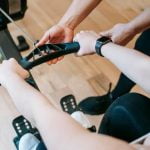Exercising regularly is crucial for maintaining optimal body fitness. Whether you are looking to lose weight, improve your strength and endurance, or simply enhance your overall well-being, exercise plays a vital role in achieving these goals. In this article, we will delve into the importance of exercise for body fitness and provide you with essential tips on how to incorporate effective workouts into your daily routine.
Exercise not only helps to improve physical health but also has significant benefits for mental and emotional well-being. It has been proven to reduce the risk of chronic diseases such as heart disease, diabetes, and certain types of cancer. Regular exercise also improves mood, reduces stress levels, and enhances cognitive function. In addition, it aids in better sleep patterns and boosts self-confidence.
To begin your journey towards body fitness, it is important to set clear fitness goals that align with your aspirations and desires. These goals will act as a roadmap for your workout routine and help measure progress along the way. Once you have defined your desired fitness level, you can tailor your exercise regimen accordingly.
The key to exercising effectively lies in choosing the right type of exercise that suits your body’s needs. Each person is unique and may require different forms of exercise based on their current fitness level, preferences, and any medical conditions they may have.
Whether it’s cardiovascular exercises like running or swimming or strength training exercises like weightlifting or resistance training – finding an activity that you enjoy will make it more likely for you to stick with it in the long run.
Setting Fitness Goals
Defining Your Fitness Goals
To begin with, take some time to reflect on what you hope to accomplish through exercise. Are you looking to lose weight, build muscle, increase endurance, or improve flexibility? Consider both short-term and long-term goals, as well as any specific milestones you would like to reach along the way. Having a clear idea of what success looks like for you will make it easier to stay focused and committed.
SMART Goal Setting
Once you have defined your desired fitness level, it’s helpful to set SMART goals. SMART is an acronym that stands for Specific, Measurable, Attainable, Relevant, and Time-Bound. This framework ensures that your goals are well-defined and achievable.
- Specific – Clearly state what exactly you want to accomplish. For example, instead of saying “I want to get stronger,” specify “I want to be able to do 10 push-ups”.
- Measurable – Establish concrete criteria or methods for tracking your progress. This could be the amount of weight lifted or the number of reps completed.
- Attainable – Set goals that are challenging but still within reach. Make sure they align with your current fitness level and consider any potential barriers or limitations.
- Relevant – Ensure that your goals are meaningful and relevant to your overall fitness plan. They should align with your interests and motivations.
- Time-Bound – Set a deadline for achieving each goal. This helps create a sense of urgency and allows you to track your progress over time.
Creating a Plan
Once you have set your fitness goals, it’s time to create a plan to achieve them. This involves breaking down your goals into smaller, actionable steps and creating a timeline for when you will complete each step. Consider factors such as the frequency and duration of your workouts, the types of exercises you will incorporate, and any necessary adjustments to your lifestyle or schedule.
Having a well-structured plan in place can help you stay motivated and accountable. It also allows you to track your progress more effectively and make modifications as needed. Remember to be flexible and adjust your plan if necessary, as goals may change over time or new opportunities may arise.
By setting clear fitness goals, utilizing the SMART framework, and creating a solid plan, you are laying the foundation for success on your body fitness journey. Taking the time to define and understand what you want to achieve will keep you focused and motivated throughout the process. With dedication and perseverance, you can work towards achieving your desired fitness level and experience the numerous benefits that come with it.
Getting Started
When embarking on a body fitness journey, it is crucial to choose the right type of exercise that suits your individual needs and goals. There are various forms of exercise to consider, including cardiovascular exercises, strength training, and flexibility and stretching activities. Deciding which type to pursue can be overwhelming, but with some guidance, you can make an informed decision that will set you up for success.
Firstly, consider your overall fitness goals. Are you looking to improve your endurance and cardiovascular health? Or maybe you want to build lean muscle mass and enhance your strength? Understanding what you hope to achieve through exercise will help direct you towards the appropriate type of workout.
Secondly, take into account your personal preferences and interests. If you dread going for a run but find joy in participating in group classes or dancing, then a cardio workout centered around those activities may be more enjoyable for you. Remember that finding an exercise routine that excites you and keeps you motivated is key to maintaining a long-term commitment.
Lastly, consult with professionals if needed. If you are unsure about which type of exercise would be most suitable for your body fitness journey or have any concerns about existing health conditions or injuries, seek advice from qualified individuals such as personal trainers or healthcare providers. They can provide valuable insights based on their expertise and ensure that your exercise regimen aligns with your specific needs and abilities.
Choosing the right type of exercise is instrumental in setting a solid foundation for your body fitness journey. By understanding your goals, preferences, and seeking professional guidance when necessary, you can make an informed decision that not only meets your individual needs but also maximizes the enjoyment and effectiveness of your workouts.
| Benefits | Considerations |
|---|---|
| Improves cardiovascular health and endurance | Certain exercises may require specific equipment or facilities |
| Increases strength and muscle mass | Some activities may have a higher risk of injury |
| Promotes flexibility and prevents injuries | Personal preferences and interests may differ |
Building a Solid Exercise Routine
Establishing a sustainable and effective workout schedule is crucial in building a solid exercise routine that promotes long-term body fitness. Without a consistent and well-planned schedule, it can be challenging to stay motivated and achieve your fitness goals. In this section, we will explore some tips and strategies to help you create a workout schedule that works for you.
Determine Your Exercise Goals
Before creating a workout schedule, it’s essential to determine your exercise goals. Are you looking to lose weight, gain muscle mass, improve cardiovascular endurance, or enhance overall strength? Understanding your goals will help guide the types of exercises you should include in your routine and the frequency at which you should perform them.
Assess Your Availability
Next, assess your availability and find pockets of time in your daily or weekly schedule that can be dedicated to exercise. Consider factors such as work hours, family commitments, and personal preferences when determining the ideal time for your workouts. Some people prefer early morning workouts before their day begins, while others may find evening workouts more suitable. Find a time that works best for you and try to stick to it consistently.
Choose the Right Types of Exercise
When building a solid exercise routine, it’s important to choose activities that cater to different aspects of fitness such as cardiovascular endurance, strength training, and flexibility. Incorporate a mix of activities like running, cycling, weightlifting, yoga, or swimming into your schedule. This variety will not only keep your workouts interesting but also help you target different muscle groups and prevent boredom or burnout.
Gradually Increase Intensity
As you establish your exercise routine and become comfortable with the exercises you’ve chosen, it’s important to gradually increase the intensity of your workouts over time. Start with manageable weights or distances and progressively challenge yourself by adding more weight, increasing reps, or extending workout durations. This gradual progression will help prevent injury and ensure that your body continues to adapt and improve.
Include Rest Days
Rest days are equally as important as workout days in a solid exercise routine. They give your body time to recover and repair itself, allowing you to avoid overtraining and reduce the risk of injury. Plan for at least one or two rest days per week where you engage in low-intensity activities like stretching, walking, or light yoga.
By following these guidelines and adjusting them to fit your individual needs and preferences, you can create a workout schedule that is sustainable and effective for achieving long-term body fitness goals. Remember to be consistent, listen to your body, and make adjustments as needed along the way.
Cardiovascular Exercises
Cardiovascular exercise, also known as cardio, plays a crucial role in enhancing overall endurance and improving heart health. Engaging in regular cardiovascular exercises helps elevate the heart rate, increase lung capacity, and improve blood circulation throughout the body. This section will explore the different types of cardiovascular exercises available and their benefits for achieving optimal body fitness.
There are various forms of cardiovascular exercises that individuals can choose from based on their preferences and fitness levels. Running is a popular option that can be done both outdoors and on a treadmill. It is a high-impact exercise that effectively elevates the heart rate and tones muscles in the lower body.
Cycling is another excellent cardio exercise, whether it’s cycling outdoors or using a stationary bike. It is a low-impact activity that helps strengthen leg muscles while minimizing stress on joints.
For those who prefer low-impact exercises, swimming is an ideal choice as it provides a full-body workout without putting stress on the joints. Jumping rope is another versatile cardio activity that can easily be incorporated into a daily routine, requiring minimal equipment while effectively engaging multiple muscle groups.
Engaging in regular cardiovascular exercises offers numerous benefits beyond improving endurance. It contributes to weight loss by burning calories and boosting metabolism, supports mental well-being by releasing endorphins, reduces the risk of chronic diseases such as heart disease and diabetes, improves sleep quality, and enhances overall energy levels.
To track progress and stay motivated during cardiovascular workouts, individuals can use wearable fitness trackers to monitor heart rate, calories burned, distance covered, and other relevant metrics. Setting specific goals for duration or distance can help individuals stay focused on their cardio journey and achieve continuous improvements over time.
Table: Different Types of Cardiovascular Exercises
| Exercise Type | Description |
|---|---|
| Running | High-impact exercise that elevates heart rate and tones lower body muscles |
| Cycling | Low-impact activity that strengthens leg muscles and is suitable for both indoor and outdoor settings |
| Swimming | Full-body workout with minimal stress on joints, improving cardiovascular health and muscle tone |
| Jumping Rope | Versatile cardio activity that engages multiple muscle groups and can be easily incorporated into daily routines |
Strength Training
One of the primary advantages of strength training is its ability to increase muscle strength and power. By engaging in activities that target specific muscle groups, such as weightlifting or resistance band exercises, you can gradually challenge your muscles to lift heavier loads.
This progressive overload stimulates muscle growth and adaptation, allowing you to develop increased levels of strength over time. Not only does this benefit day-to-day tasks like carrying groceries or lifting heavy objects, but it also enhances performance in sports and physical activities.
In addition to building strength, strength training also helps improve bone density and reduce the risk of osteoporosis. Weight-bearing exercises such as squats and lunges put stress on the bones, which stimulates them to become stronger and denser. This is especially important for individuals at risk for osteoporosis, such as women in postmenopausal stages. By incorporating regular strength training exercises into their routine, individuals can significantly lower their risk of developing brittle bones and fractures.
To incorporate strength training into your exercise routine effectively, it’s essential to focus on proper form and technique. It is recommended to start with lighter weights or resistance bands and gradually increase the load as your muscles get stronger. Additionally, alternating between different muscle groups allows for adequate recovery time while still maintaining consistent progress. By using a variety of equipment such as dumbbells, barbells, or machines, you can target different muscle groups from various angles for comprehensive development.
In summary, including strength training in your exercise program provides numerous benefits ranging from increased muscle mass to enhanced bone density. By focusing on proper form, gradually increasing weight loads, and allowing for adequate rest and recovery, you can build lean muscle mass and boost your overall body strength. Whether you are a beginner or an experienced fitness enthusiast, incorporating strength training exercises into your routine is an excellent way to support long-term body fitness.
Flexibility and Stretching
One of the main advantages of maintaining flexibility is that it allows for better performance during physical activities. Whether you’re a professional athlete or a regular gym-goer, having good flexibility enables you to move more efficiently and effectively in various exercises. It improves your balance, coordination, and agility, making your workouts safer and more enjoyable.
In addition to better performance, being flexible also reduces the risk of injuries. When our muscles and joints can move through their full range of motion without strain or excess tension, we reduce the chances of pulling a muscle or straining a joint.
Proper stretching before and after exercise helps warm up the muscles, increase blood flow to the tissues, and prepare them for physical activity. It also aids in alleviating post-workout soreness by releasing built-up lactic acid in the muscles.
| Benefit | Description |
|---|---|
| Improved Performance | Having good flexibility enhances balance, coordination, and agility during physical activities. |
| Injury Prevention | Maintaining flexibility reduces the risk of muscle strains and joint injuries. |
Moreover, flexibility exercises such as yoga or Pilates contribute to overall well-being by promoting relaxation and reducing stress levels. These types of activities focus on controlled movements combined with deep breathing techniques that engage both body and mind. Regular practice can enhance mental clarity, reduce anxiety, and improve sleep quality.
To incorporate flexibility and stretching into your exercise routine, it is recommended to stretch all major muscle groups at least two to three times a week. There are different types of stretches, such as static and dynamic stretches, for targeting specific areas of the body. It’s important to ease into each stretch slowly without bouncing or forcing the movement. Hold each stretch for 15-30 seconds to allow the muscles to elongate gradually.
By making flexibility and stretching a regular part of your exercise regimen, you can enhance your overall fitness level, prevent injuries, and improve your physical performance. So take the time to incorporate these exercises into your routine and experience the benefits they bring to both your body and mind.
Nutrition and Hydration
Proper nutrition and hydration are essential factors for achieving optimal performance and recovery during your body fitness journey. The food you eat before, during, and after exercise plays a crucial role in supplying your body with the necessary nutrients, energy, and hydration to perform at its best.
When it comes to nutrition, it is important to focus on consuming a balanced diet that includes carbohydrates, protein, and healthy fats. Carbohydrates provide the main source of energy for your muscles during exercise, so incorporating complex carbs like whole grains, fruits, and vegetables into your meals can help fuel your workouts.
Protein is essential for repairing and building muscle tissue, so make sure to include lean sources of protein such as chicken breast, tofu, or legumes in your diet. Healthy fats are also important for providing sustained energy throughout the day and can be found in foods like avocados, nuts, and olive oil.
In addition to proper nutrition, staying hydrated is key to optimizing your performance and aiding in recovery. Water is crucial for maintaining bodily functions and regulating body temperature during exercise.
It is recommended to drink water before, during (especially for longer workouts), and after exercising to replenish fluids lost through sweat. If you are engaging in intense physical activity or exercising in a hot environment, sports drinks or electrolyte-rich beverages may also be beneficial for rehydrating and replenishing electrolytes lost through sweat.
In summary, paying attention to your nutrition and hydration is vital for achieving optimal performance during your body fitness journey. Prioritize consuming a well-rounded diet that includes complex carbohydrates, lean proteins, and healthy fats to fuel your workouts and aid in muscle repair. Additionally, remember to stay hydrated by drinking plenty of water before, during, and after exercise. These strategies will help optimize your performance levels while promoting effective recovery.
Monitoring Progress
Keeping track of your fitness progress is an essential aspect of any successful body fitness journey. By monitoring your progress, you can assess your improvement, stay motivated, and make adjustments to your workout routine or diet as needed. In this section, we will explore some effective tracking methods that can help you measure your body fitness journey and achieve your desired goals.
Setting Clear Objectives
Before diving into the various ways you can track your progress, it’s important to establish clear objectives and goals for yourself. This will give you a benchmark to measure against and provide a sense of direction in your fitness journey. Whether you want to lose weight, increase stamina, or build muscle mass, having specific targets in mind will allow you to choose the most appropriate tracking methods.
Measuring Physical Performance
One way to monitor your progress is by measuring changes in physical performance. This can include tracking metrics such as running speed, the number of push-ups or pull-ups you can do, or the amount of weight you can lift.
By recording these measurements regularly over time, you will be able to see improvements in strength and endurance. Additionally, tools like fitness apps or wearable devices can provide accurate data and allow for easy tracking of steps taken, calories burned, heart rate, and sleep patterns.
Assessing Body Composition
Another important aspect of tracking progress is assessing changes in body composition. This involves measuring factors such as body weight, body fat percentage, or taking waist circumference measurements. While the scale alone is not always an accurate reflection of overall health and fitness progress since it doesn’t differentiate between muscle and fat loss/gain; combining it with other measurements can provide a more comprehensive picture of changes happening within your body.
Keeping a Fitness Journal
In addition to using objective tracking methods, many people find it helpful to keep a fitness journal. This can be a simple notebook or even a fitness app where you record your workouts, diet, and how you feel physically and mentally after each session.
By documenting your progress in this way, you can gain insights into patterns or trends that may be affecting your performance. It also allows you to reflect on your journey and celebrate the small victories along the way.
Remember that everyone’s body is unique, and progress may vary from person to person. It’s important not to compare yourself to others but rather focus on your own improvements. By implementing effective tracking methods and regularly monitoring your progress, you will have a clear understanding of how far you’ve come and the motivation to keep pushing forward towards achieving optimal body fitness.
Overcoming Challenges
Embarking on a body fitness journey can be quite exhilarating at first, but as you progress, you may encounter various challenges that can hinder your motivation and progress. Understanding how to overcome these hurdles is crucial for maintaining long-term body fitness. The three main obstacles that individuals often face are plateaus in their progress, motivation slumps, and the risk of exercise-related injuries.
A plateau refers to a period where your body stops making noticeable improvements despite consistent effort. It can be frustrating when you feel like you’ve hit a wall and aren’t seeing any results. To overcome plateaus, it’s important to vary your workouts by trying new exercises or increasing the intensity of your current routine. Additionally, incorporating cross-training into your regimen can provide a fresh challenge for your body and help break through the plateau.
Motivation slumps are another common obstacle that many individuals encounter during their fitness journeys. It’s completely normal to feel demotivated at times, especially when results aren’t coming as quickly as expected. To combat this, it’s essential to find ways to stay inspired and rekindle your passion for exercise. Setting small achievable goals, finding an exercise buddy or joining group classes can provide the extra support and accountability needed to push through these slumps.
Lastly, preventing exercise-related injuries is crucial for maintaining an effective workout routine. Injuries not only set back your progress but also cause pain and discomfort. To minimize the risk of injuries while exercising, always prioritize proper form and technique. Start slowly and gradually increase intensity or weight to prevent overexertion or strains on muscles and joints. Warm-up before each workout session and spend time stretching afterward to improve flexibility and prevent muscle tightness.
Celebrating Achievements
Recognizing Milestones and Accomplishments
When it comes to maintaining body fitness as a lifestyle choice, it’s important to acknowledge and celebrate your achievements along the way. One of the keys to staying motivated and committed to your exercise routine is to regularly recognize the milestones you reach and the accomplishments you achieve. By taking the time to celebrate your progress, you not only boost your self-confidence but also reinforce the positive habits that lead to long-term body fitness.
Embracing a Positive Mindset
Embracing body fitness as a lifestyle choice goes beyond physical changes; it also involves cultivating a positive mindset. Instead of focusing solely on how you look or comparing yourself to others, shift your focus towards feeling strong, energized, and healthy. By adopting a positive mindset, you can better maintain motivation and see exercise as an opportunity for personal growth rather than a chore.
Another way to embrace a positive mindset is by setting realistic expectations for yourself. Understand that progress takes time, and there will be days when you may not perform at your best or achieve the desired results. Be kind to yourself during setbacks and failures, and remember that every step forward counts in the larger journey towards maintaining body fitness.
Enjoying the Process
Celebrating achievements in body fitness should be more than just reaching a specific weight or fitting into a certain clothing size. It’s about finding joy in the process of exercising and embarking on new challenges. Explore different types of exercises, join group classes or sports teams, or incorporate outdoor activities into your routine – these are all ways to make workouts more enjoyable.
Additionally, find ways to reward yourself for staying consistent with your exercise routine. Treat yourself to something special after accomplishing a goal such as buying new workout gear or treating yourself to a massage. By creating small rewards along the way, you build positive associations with exercise and reinforce the idea that body fitness is something worth celebrating.
Ultimately, by embracing and maintaining body fitness as a lifestyle choice, you cultivate a sense of fulfillment, happiness, and overall well-being. Celebrating achievements not only keeps you motivated but also allows you to acknowledge the progress you’ve made and encourages continuous growth in your fitness journey. Remember to enjoy the process, celebrate milestones, and maintain a positive mindset as you navigate towards long-term body fitness success.
Conclusion
In conclusion, incorporating effective exercise into your daily routine is essential for achieving and maintaining long-term body fitness. By understanding the importance of exercise and setting clear fitness goals, you can create a roadmap for success. It is crucial to choose the right type of exercise that suits your preferences and abilities, ensuring that you enjoy the process and stay motivated.
Building a solid exercise routine is key to establishing a sustainable and effective workout schedule. Consistency is vital, so aim to engage in regular cardiovascular exercises, which elevate your heart rate and improve overall endurance. Additionally, incorporate strength training exercises to build lean muscle mass and enhance your body’s strength.
Flexibility and stretching should not be overlooked as they offer numerous benefits such as increased range of motion and prevention of injuries. Remember to fuel your body with proper nutrition and hydration, providing it with the necessary nutrients to perform optimally during workouts and recover effectively afterwards.
Monitoring progress using tracking methods allows you to see how far you’ve come in your body fitness journey. This not only serves as motivation but also helps identify areas for improvement or potential plateaus. Overcoming challenges such as motivation slumps or exercise-related injuries requires perseverance but is crucial for long-term success.
Lastly, embracing body fitness as a lifestyle choice is key to maintaining your achievements. By making exercise a habit and finding enjoyment in physical activity, it becomes easier to sustain an active lifestyle. Celebrate each milestone achieved along the way, whether it’s reaching a personal best or simply sticking to your workout routine consistently.
Incorporating effective exercise into your life will not only benefit your physical health but also positively impact other areas such as mental well-being and overall quality of life. So start today by incorporating these key takeaways into your daily routine and enjoy the journey towards long-term body fitness.
Frequently Asked Questions
How Do I Start Body Fitness?
Starting body fitness involves making a commitment to prioritize your physical health and well-being. The first step is to set clear goals regarding what you hope to achieve through your fitness journey. This could be improving strength, losing weight, or simply maintaining overall fitness.
Once you have identified your goals, it’s important to create a balanced exercise routine that incorporates cardiovascular activities, strength training exercises, and flexibility exercises. It’s advisable to start with moderate intensity workouts and gradually increase the duration and intensity as your body becomes accustomed to the routine. Additionally, adopting a healthy diet and staying consistent with workouts are key factors in starting body fitness.
How Do You Train Body Fitness?
Training for body fitness requires a well-rounded approach that includes various types of exercises targeting different muscle groups. Cardiovascular exercises like running, swimming, or cycling help improve stamina and burn calories. Strength training exercises such as weightlifting or bodyweight exercises like push-ups and squats help build muscle mass and increase strength.
Flexibility exercises like yoga or stretching can improve range of motion and prevent injuries. It’s important to schedule regular workout sessions throughout the week while allowing for adequate rest days to ensure optimal recovery. Working with a certified personal trainer can also be helpful in designing an effective training program tailored to individual goals.
How Can I Improve My Body Fitness?
Improving body fitness is an ongoing process that requires consistency and dedication. To enhance your body fitness level, it’s crucial to maintain a regular exercise routine by incorporating both cardiovascular activities and strength training exercises into your workouts. This helps improve endurance, increase muscular strength, tone the body, and promote overall health. In addition to physical exercise, paying attention to nutrition is equally important in improving body fitness.
Consuming a balanced diet rich in lean proteins, whole grains, fruits, vegetables, and healthy fats can provide the necessary nutrients for muscle growth and energy levels during workouts. Adequate hydration is also essential for proper bodily functions and performance during exercise sessions. Lastly, listening to your body, getting enough rest, and taking breaks when needed is crucial to avoid overexertion and prevent injuries.

Passionate about providing useful information to anyone with an interest in the field of Personal Training, I strive to pass on to our readers quality information and to answer any questions about Personal Trainers, the work they do and how to become one.





